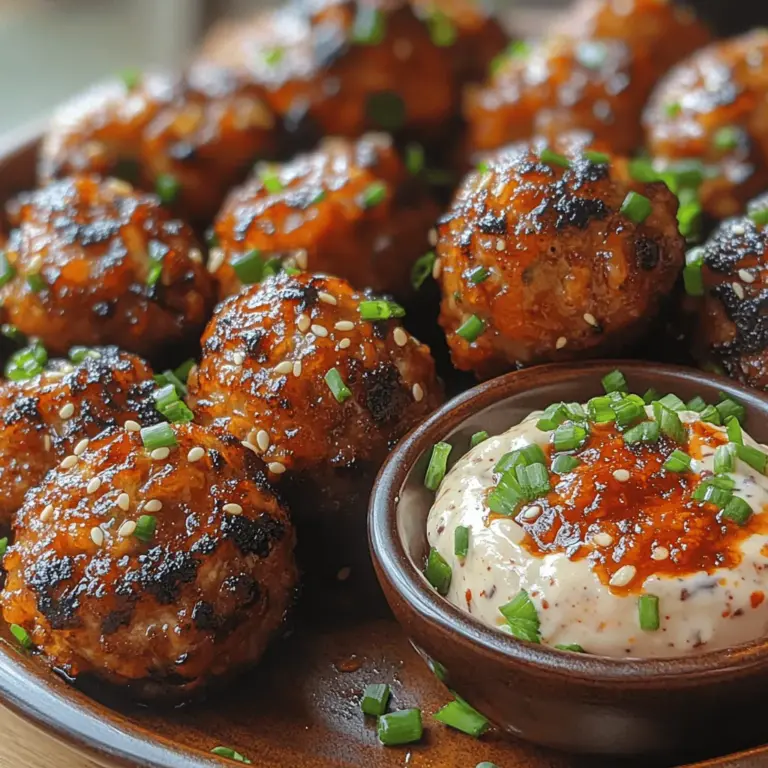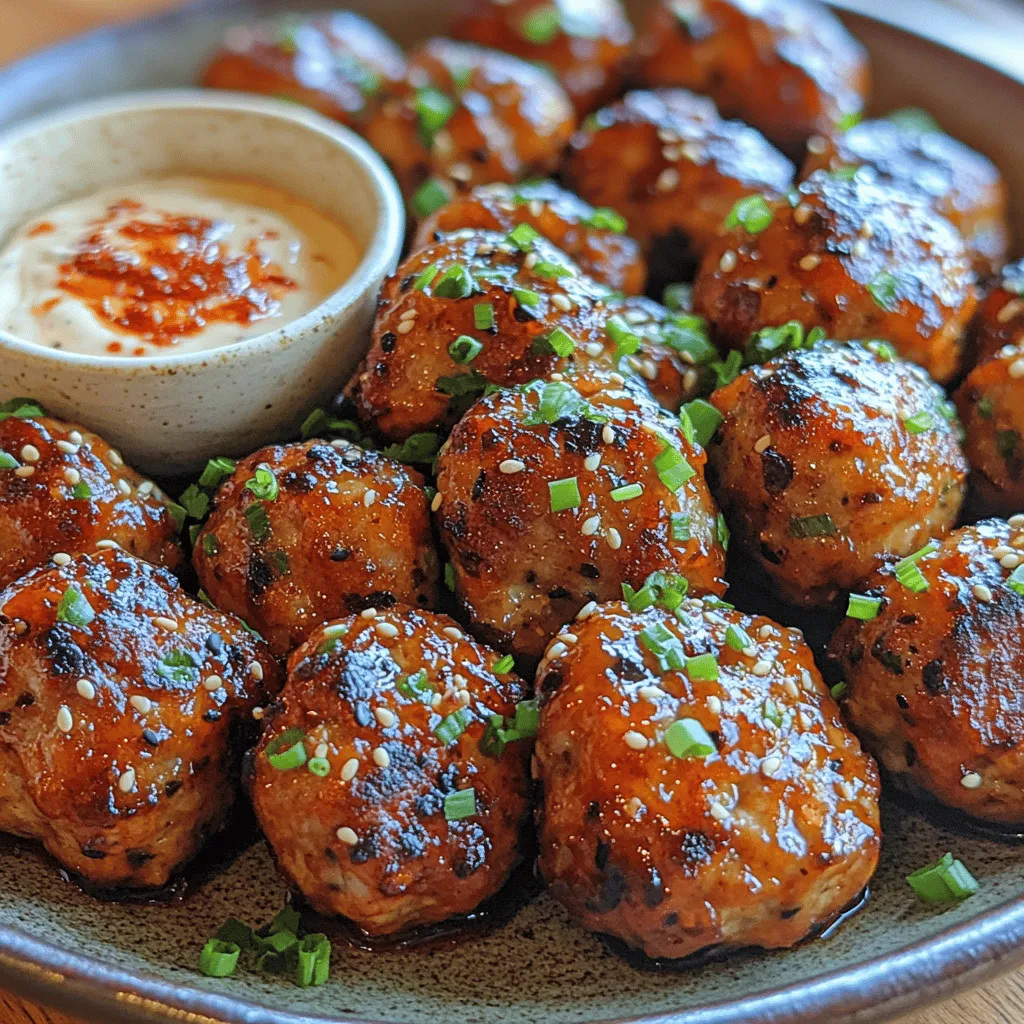Introduction to Korean BBQ Meatballs with Spicy Mayo Dip
Korean cuisine has gained immense popularity worldwide, largely thanks to its bold flavors, vibrant colors, and unique cooking techniques. From the sizzling grills of Korean BBQ to the comforting bowls of kimchi stew, the culinary landscape of Korea is diverse and inviting. One dish that beautifully encapsulates the essence of Korean flavors while offering a modern twist is Korean BBQ Meatballs with Spicy Mayo Dip.
These meatballs combine the rich, savory taste of marinated meat with a creamy and spicy dipping sauce, creating a delightful balance of flavors and textures. The dish is not only delicious but also visually appealing, making it a favorite for a variety of occasions, from casual family dinners to festive gatherings. Whether served as an appetizer or a main course, these meatballs are sure to impress your guests and satisfy your cravings.
The versatility of Korean BBQ Meatballs makes them suitable for any occasion. They can be served on skewers for easy handling at parties, added to a rice bowl for a hearty meal, or enjoyed as a snack with friends during movie nights. The combination of tender meatballs and a zesty spicy mayo dip ensures that each bite is a celebration of flavor that brings a taste of Korea to your table.
Understanding the Ingredients
To make authentic Korean BBQ Meatballs, it’s essential to understand the key ingredients that contribute to their unique flavor profile. Let’s delve into what makes these meatballs special.
Key Ingredients for the Meatballs
Ground Meat: A key decision when preparing Korean BBQ Meatballs is choosing between ground beef and pork. Ground beef offers a slightly richer flavor, while pork lends a bit of sweetness. Both options can work well, but a combination of the two often yields the best results, providing a balance of flavor and tenderness.
Breadcrumbs: Breadcrumbs play a crucial role in achieving the perfect meatball consistency. They help bind the meat mixture together while also absorbing moisture, leading to tender, juicy meatballs. Using panko breadcrumbs can add an extra crispy texture, while regular breadcrumbs are a great option for a more classic approach.
Aromatics: The trio of green onions, garlic, and ginger is essential for infusing the meatballs with a burst of flavor. Green onions add a subtle sharpness and freshness, while garlic and ginger provide depth and warmth. These aromatics are staples in Korean cooking, contributing to the dish’s overall authenticity.
Soy Sauce and Sesame Oil: No Korean dish is complete without the umami-rich notes of soy sauce and the nutty aroma of sesame oil. Soy sauce enhances the savory aspect of the meatballs, while sesame oil adds a distinct flavor characteristic of Korean cuisine. Together, they create a complex and delicious base for the meatballs.
Brown Sugar: Adding a touch of brown sugar is key to balancing the savory flavors. It introduces a hint of sweetness that complements the other ingredients, making each bite more enjoyable. The caramelization that occurs during cooking also adds depth to the flavor.
Egg: An often-overlooked ingredient, the egg acts as a binder that holds the meatball mixture together, ensuring they maintain their shape during cooking. It also adds moisture, contributing to a tender texture.
Exploring the Spicy Mayo Dip
The Spicy Mayo Dip is the perfect companion to these Korean BBQ Meatballs, enhancing their flavor with its creamy and zesty profile.
Mayonnaise: The base of the dip is mayonnaise, which provides a rich and creamy texture. It serves as a wonderful canvas for the other flavors, making the dip addictive and smooth.
Gochujang: This Korean chili paste is a must-have ingredient for the dip, bringing a spicy kick and a touch of sweetness. Gochujang is made from fermented soybeans, glutinous rice, and red chili powder, giving it a unique flavor that is both spicy and savory. The addition of gochujang transforms the mayo into a vibrant, flavorful dip that pairs perfectly with the meatballs.
Other Ingredients: Depending on personal preference, you can enhance the dip with additional ingredients such as lime juice for a tangy bite, honey for extra sweetness, or even a splash of rice vinegar for acidity. Each of these elements works together to create a harmonious blend of spicy, tangy, and sweet flavors.
Optional Garnishes: To elevate the presentation of your dish, consider garnishing the meatballs with sliced green onions or sesame seeds. Not only do these toppings add visual appeal, but they also contribute additional flavor and texture.
Step-by-Step Guide to Making Korean BBQ Meatballs
Now that you have a good understanding of the ingredients, it’s time to dive into the step-by-step process of making these delicious Korean BBQ Meatballs.
Preparing the Meatball Mixture
1. Mixing the Ingredients: Start by gathering all your ingredients. In a large mixing bowl, combine the ground meat, breadcrumbs, chopped green onions, minced garlic, grated ginger, soy sauce, sesame oil, brown sugar, and the egg.
2. Proper Mixing Techniques: Use your hands to mix the ingredients thoroughly, but be careful not to over-mix. Over-mixing can lead to tough meatballs. The goal is to combine the ingredients just enough to ensure even distribution.
3. Achieving the Right Texture: The mixture should be moist but not overly sticky. If it feels too wet, you can add a bit more breadcrumbs until you reach the desired consistency.
Forming the Meatballs
1. Suggested Size and Yield: Once the mixture is ready, it’s time to form the meatballs. Aim for a size of about 1 to 1.5 inches in diameter. This size yields approximately 20-25 meatballs, perfect for sharing.
2. Uniform Shape and Size: To ensure even cooking, use a cookie scoop or your hands to portion out the mixture. Roll each portion into a ball, making sure they are uniform in size for consistent cooking. This attention to detail will help achieve a perfect golden crust on each meatball.
Cooking the Meatballs
1. Best Methods for Frying: There are various methods to cook meatballs, including baking, frying, or grilling. For this recipe, frying in a skillet is recommended to achieve a crispy exterior. Heat a couple of tablespoons of oil in a large skillet over medium-high heat.
2. Importance of Temperature Control: Once the oil is shimmering, carefully add the meatballs in batches, ensuring not to overcrowd the pan. Overcrowding can lead to steaming instead of browning. Cook for about 4-5 minutes on each side or until they are golden brown and cooked through.
3. Achieving a Golden Brown Crust: To check for doneness, use a meat thermometer to ensure the internal temperature reaches 165°F (74°C). The golden crust will not only enhance the flavor but also add an appealing texture to the meatballs.
By following these steps, you’ll have a batch of delicious Korean BBQ Meatballs ready to be paired with the Spicy Mayo Dip. As you prepare this dish, you’ll find that the combination of aromatic ingredients and cooking techniques results in a meal that celebrates the rich culinary traditions of Korea. Stay tuned for the next part of this article, where we will delve deeper into serving suggestions and variations to make this dish your own.
Ensuring Meatballs Are Cooked Through and Safe to Eat
Cooking meatballs to the proper internal temperature is crucial for both safety and optimal texture. To ensure your Korean BBQ meatballs are perfectly cooked, invest in an instant-read meat thermometer. Insert the thermometer into the center of a meatball; it should read at least 160°F (71°C) for ground beef and 165°F (74°C) for poultry. If you find that your meatballs are not quite there, return them to the oven and check every few minutes until they reach the desired temperature.
Additionally, when baking, it’s important to space your meatballs evenly on the baking sheet. This allows for even cooking and browning, which enhances the flavor. If you’re pan-frying your meatballs, make sure they are browned on all sides, indicating that they are cooked through. The aroma of the meatballs will fill your kitchen, and the caramelization of the sauce will provide an irresistible glaze that makes these bites truly delectable.
Crafting the Spicy Mayo Dip
Creating the spicy mayo dip is straightforward and can elevate your Korean BBQ meatballs to new heights. Here’s how to make it:
Ingredients for Spicy Mayo Dip:
– 1 cup mayonnaise
– 2 tablespoons gochujang (Korean chili paste)
– 1 tablespoon rice vinegar
– 1 teaspoon sesame oil
– 1 teaspoon sugar (optional)
– 1 clove garlic, minced
– Salt to taste
Steps to Create the Dip:
1. Combine Ingredients: In a medium-sized mixing bowl, add the mayonnaise, gochujang, rice vinegar, sesame oil, sugar, and minced garlic.
2. Mix Thoroughly: Using a whisk or a fork, mix the ingredients together until you achieve a smooth and creamy consistency. Ensure that the gochujang is fully incorporated into the mayonnaise to avoid any lumps.
3. Taste and Adjust: After mixing, taste your dip. If you prefer a spicier kick, add more gochujang. For a touch of sweetness to balance the heat, incorporate additional sugar or a drizzle of honey. If it’s too spicy, you can add more mayonnaise to tone it down.
4. Chill: Cover the dip with plastic wrap and refrigerate for at least 30 minutes before serving. This helps the flavors meld together beautifully.
Presentation Tips: Serve the spicy mayo dip in a small bowl alongside the meatballs. You can garnish it with a sprinkle of sesame seeds or finely chopped green onions for an appealing touch.
Serving Suggestions and Pairings
When it comes to serving your Korean BBQ meatballs, presentation is key. Here are some ideas to make your dish visually appealing and delicious:
1. Plating Techniques: Arrange the meatballs on a large platter, drizzling the spicy mayo dip over the top for added flair. Alternatively, serve the meatballs on skewers for easy handling, especially if you’re hosting a party.
2. Accompaniments: Consider pairing your meatballs with:
– Steamed Rice: A classic side that complements the rich flavors of the meatballs.
– Kimchi: A tangy and spicy fermented vegetable dish that enhances the meal with its crunch and acidity.
– Fresh Vegetables: Serve with cucumber or carrot sticks for a refreshing contrast.
– Beverages: Pair with a light beer or soju, a traditional Korean distilled beverage, which balances the richness of the dish.
3. Versatility: The beauty of Korean BBQ meatballs lies in their versatility. They work wonderfully as:
– Appetizers: Perfect for gatherings, served with toothpicks for easy eating.
– Main Course: Serve over a bed of rice or noodles for a hearty meal.
– Party Food: Ideal for potlucks or game day, where they can be kept warm in a slow cooker.
Health and Nutritional Insights
Understanding the nutritional aspects of your Korean BBQ meatballs can help you make informed choices. Here’s a breakdown:
1. Nutritional Breakdown: A serving of meatballs (typically around 4-6 meatballs) contains approximately:
– Calories: 250-300
– Protein: 15-20 grams
– Carbohydrates: 6-10 grams
– Fat: 15-20 grams
2. Health Benefits: Key ingredients like garlic and sesame oil offer health benefits, including anti-inflammatory properties and heart health support. Leaner meats can also provide essential proteins without excessive saturated fats.
3. Dietary Adjustments: If you’re looking to modify the recipe for dietary restrictions:
– Gluten-Free: Use gluten-free breadcrumbs or oats instead of traditional breadcrumbs.
– Low-Carb: Substitute breadcrumbs with crushed cauliflower or almond flour to reduce carbs significantly.
– Vegan/Vegetarian: Replace ground beef with a plant-based alternative like lentils, chickpeas, or a meat substitute, and use vegan mayonnaise for the dip.
Cultural Significance of Korean BBQ
Korean BBQ has deep cultural roots, signifying a communal and lively dining experience. Traditionally, BBQ in Korea involves grilling meats at the table, allowing diners to enjoy the process and flavors together. Meatballs, while not a traditional BBQ item, embody the fusion of Korean flavors and the global appeal of BBQ culture.
Historically, the evolution of Korean BBQ reflects the country’s agricultural practices and culinary innovations. The incorporation of various marinades and spices, like gochujang, showcases the rich flavors of Korean cuisine. The meatball, in this context, can be seen as a modern adaptation, bridging traditional and contemporary culinary practices while remaining true to the essence of Korean flavors.
Conclusion: The Allure of Korean BBQ Meatballs with Spicy Mayo Dip
Korean BBQ meatballs with spicy mayo dip is a delightful dish that combines bold flavors, enticing aromas, and a variety of textures. The sweet and spicy notes of the meatballs harmonize beautifully with the creamy, zesty dip, making each bite a memorable experience.
Whether you are hosting a gathering, looking for a flavorful weeknight dinner, or simply craving something new, this recipe is a fantastic choice. The ease of preparation and versatility allows you to enjoy it in various settings, from casual meals to festive occasions.
We encourage you to try making these Korean BBQ meatballs at home. Share them with friends and family, and enjoy the satisfaction of creating a dish that is not only delicious but also rich in cultural significance. The combination of flavors will undoubtedly impress, and you may find this recipe becoming a go-to favorite in your culinary repertoire.


